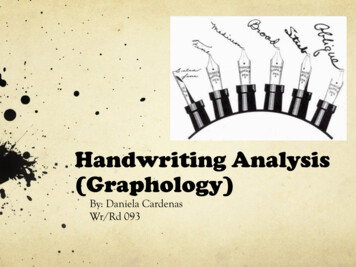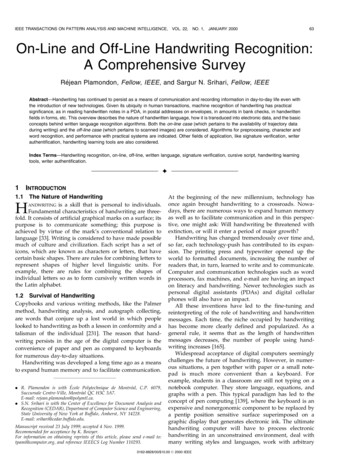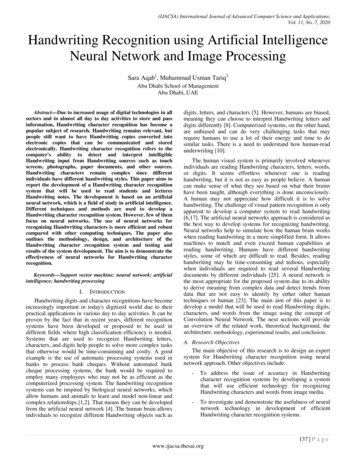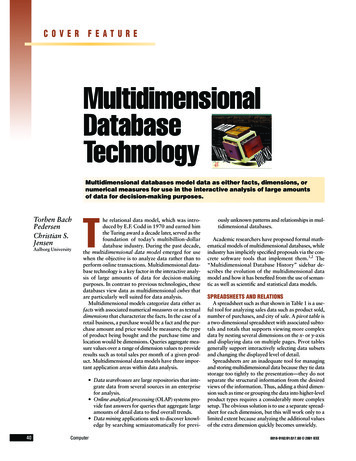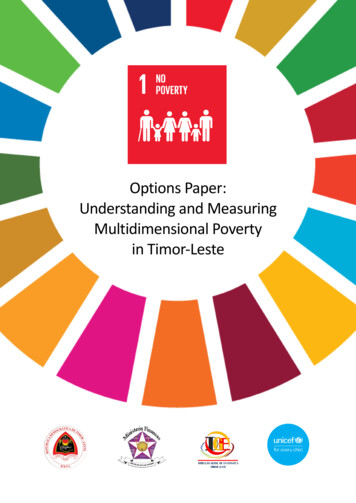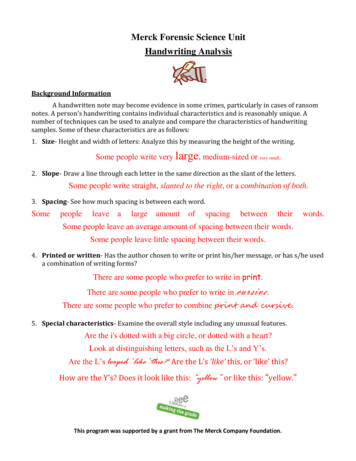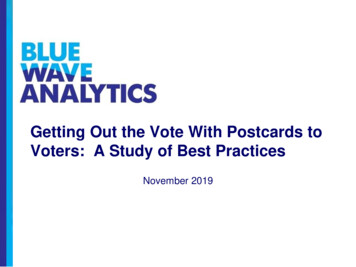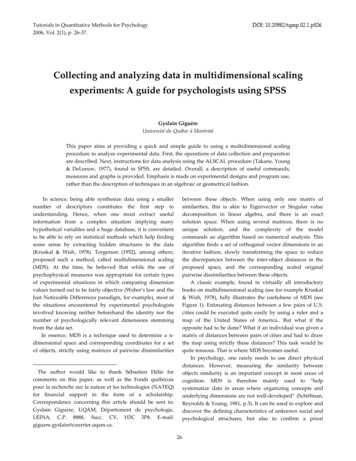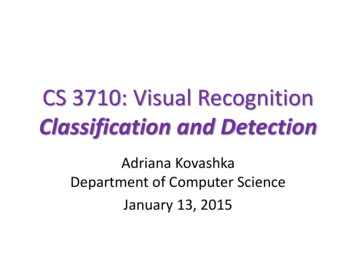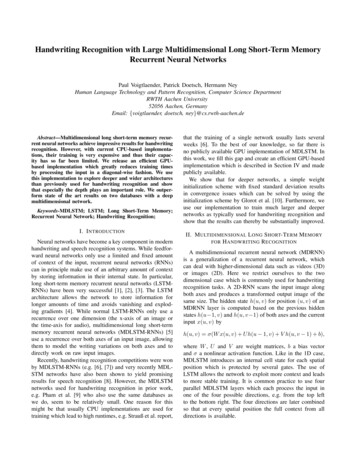
Transcription
Handwriting Recognition with Large Multidimensional Long Short-Term MemoryRecurrent Neural NetworksPaul Voigtlaender, Patrick Doetsch, Hermann NeyHuman Language Technology and Pattern Recognition, Computer Science DepartmentRWTH Aachen University52056 Aachen, GermanyEmail: {voigtlaender, doetsch, ney}@cs.rwth-aachen.deAbstract—Multidimensional long short-term memory recurrent neural networks achieve impressive results for handwritingrecognition. However, with current CPU-based implementations, their training is very expensive and thus their capacity has so far been limited. We release an efficient GPUbased implementation which greatly reduces training timesby processing the input in a diagonal-wise fashion. We usethis implementation to explore deeper and wider architecturesthan previously used for handwriting recognition and showthat especially the depth plays an important role. We outperform state of the art results on two databases with a deepmultidimensional network.Keywords-MDLSTM; LSTM; Long Short-Term Memory;Recurrent Neural Network; Handwriting Recognition;I. I NTRODUCTIONNeural networks have become a key component in modernhandwriting and speech recognition systems. While feedforward neural networks only use a limited and fixed amountof context of the input, recurrent neural networks (RNNs)can in principle make use of an arbitrary amount of contextby storing information in their internal state. In particular,long short-term memory recurrent neural networks (LSTMRNNs) have been very successful [1], [2], [3]. The LSTMarchitecture allows the network to store information forlonger amounts of time and avoids vanishing and exploding gradients [4]. While normal LSTM-RNNs only use arecurrence over one dimension (the x-axis of an image orthe time-axis for audio), multidimensional long short-termmemory recurrent neural networks (MDLSTM-RNNs) [5]use a recurrence over both axes of an input image, allowingthem to model the writing variations on both axes and todirectly work on raw input images.Recently, handwriting recognition competitions were wonby MDLSTM-RNNs (e.g. [6], [7]) and very recently MDLSTM networks have also been shown to yield promisingresults for speech recognition [8]. However, the MDLSTMnetworks used for handwriting recognition in prior work,e.g. Pham et al. [9] who also use the same databases aswe do, seem to be relatively small. One reason for thismight be that usually CPU implementations are used fortraining which lead to high runtimes, e.g. Strauß et al. report,that the training of a single network usually lasts severalweeks [6]. To the best of our knowledge, so far there isno publicly available GPU implementation of MDLSTM. Inthis work, we fill this gap and create an efficient GPU-basedimplementation which is described in Section IV and madepublicly available.We show that for deeper networks, a simple weightinitialization scheme with fixed standard deviation resultsin convergence issues which can be solved by using theinitialization scheme by Glorot et al. [10]. Furthermore, weuse our implementation to train much larger and deepernetworks as typically used for handwriting recognition andshow that the results can thereby be substantially improved.II. M ULTIDIMENSIONAL L ONG S HORT-T ERM M EMORYFOR H ANDWRITING R ECOGNITIONA multidimensional recurrent neural network (MDRNN)is a generalization of a recurrent neural network, whichcan deal with higher-dimensional data such as videos (3D)or images (2D). Here we restrict ourselves to the twodimensional case which is commonly used for handwritingrecognition tasks. A 2D-RNN scans the input image alongboth axes and produces a transformed output image of thesame size. The hidden state h(u, v) for position (u, v) of anMDRNN layer is computed based on the previous hiddenstates h(u 1, v) and h(u, v 1) of both axes and the currentinput x(u, v) byh(u, v) σ(W x(u, v) U h(u 1, v) V h(u, v 1) b),where W , U and V are weight matrices, b a bias vectorand σ a nonlinear activation function. Like in the 1D case,MDLSTM introduces an internal cell state for each spatialposition which is protected by several gates. The use ofLSTM allows the network to exploit more context and leadsto more stable training. It is common practice to use fourparallel MDLSTM layers which each process the input inone of the four possible directions, e.g. from the top leftto the bottom right. The four directions are later combinedso that at every spatial position the full context from alldirections is available.
The basic neural network architecture used in this workis depicted in Fig. 1. Similar to prior work [9], [6], [5],we stack multiple layers of alternating convolution andmultidirectional MDLSTM and after the last MDLSTMlayer, the two-dimensional sequence is collapsed to a onedimensional sequence by summing over the height axis.After the collapsing, a softmax layer with a ConnectionistTemporal Classification (CTC) [11] loss is used to handlethe alignment between the input and the output sequence.In contrast to Pham et al. [9], we use max pooling insteadof strided convolutions, because we can afford the highercomputational complexity due to the GPU implementationand max pooling is a standard component of many wellperforming computer vision systems (e.g. [12], [13]). Additionally, we apply the first convolution directly to the inputimage and don’t divide it into 2x2 blocks. Another differenceis that we average the four directions and then feed them toa single convolutional layer instead of having one separateconvolutional layer for each direction. Additionally, wefound that the training can be very unstable with standardMDLSTM cells, as the internal state can quickly increaseover time when two forget gates (one for each direction) areused [14]. Hence, we replaced them by stable LSTM cells,which were introduced by Leifert et al. [14] and solve thisproblem, for all experiments in this paper.To keep the number of hyperparameters manageable, wefix all filter sizes to 3x3 and max pooling is always appliedin non-overlapping blocks of 2x2. We use dropout of 0.25for the forward connections of all convolutional layers,MDLSTM layers and the output layer, except for the firstconvolutional layer, where we don’t use dropout as we don’twant to drop the single color channel of the input image.Additionally, we only consider layer sizes which increaselinearly with the layer index, i.e. layers get wider whenthey are closer to the output layer. For example, a networkwidth of 15n, where n is the layer index, for the networkof Fig. 1 means that the lowest convolutional layer has 15feature maps, the first MDLSTM layer has 30 hidden unitsper direction, the second convolutional layer has 45 featuremaps and so on. We call this model with a width of 15n thebasic model and use it for several experiments later on.III. DATABASESWe used two databases for experiments. The IAMdatabase [15] consists of 6,482, 976 and 2,915 lines ofEnglish handwriting for the training, development and evaluation sets. The line images of the training set have an averagewidth of 1,781 pixels with 152 pixels standard deviationand an average height of 124 pixels with 34 pixels standarddeviation. We used a smoothed word-based trigram languagemodel with a perplexity of 420 on the training set and anout of vocabulary rate of 4% on the development set. Thelanguage model was combined with a 10-gram characterlanguage model to deal with out of vocabulary words [16].The RIMES database [17] consists of 11,279 lines ofFrench handwriting for training and 778 lines for evaluation.The line images of the training set have an average width of1,665 pixels with 553 pixels standard deviation and a heightof 160 pixels with 36 pixels standard deviation. We used a4-gram word-based language model with a perplexity of 23.IV. I MPLEMENTATIONAs a direct implementation of MDLSTM in Theano usingnested calls of scan, i.e. Theano’s mechanism for loops,showed poor performance, we decided to implement itdirectly using CUDA and cuBLAS. Our GPU-based implementation is made freely available for academic researchpurposes as part of RETURNN, the RNN training softwaredeveloped by our institute, and has already been brieflydescribed in the corresponding publication [18]. We achievegood performance by pulling the non-recurrent parts of thecomputations out of the loops for the recurrences, usingcustom CUDA kernels for the MDLSTM gating mechanismand reusing memory wherever possible.In previous (CPU-based) implementations [19], the imageis processed row-wise in an outer loop and column-wise inan inner loop to make sure that for every pixel both predecessor pixels are processed before reaching it. However, wenoticed that all pixels on a common diagonal of an imagecan be processed in parallel without violating this constraint(see Fig. 2). Hence, we process images diagonal-wise andalso process multiple images and the four directions ofmultidirectional MDLSTMs simultaneously to exploit themassive parallelism offered by modern GPUs. Note thatvery recently and independently of this work, a similarparallelization scheme based on the idea to process imagesdiagonal-wise has been proposed by van den Oord et al.[20]. In their implementation, the input map of an MDLSTMlayer is explicitly skewed to transform the diagonals intocolumns which facilitates the computations. However, inour implementation this transformation is not needed, aswe use batched cuBLAS operations which take an arrayof pointers, which point to the pixels on the diagonal,as arguments. Additionally, we make our implementationpublicly available. In Stollenga et al. [21], parallelization isachieved by using a pyramidal connection topology whichis easier to implement efficiently, but changes the availablespatial context.In Table I, we compare the runtime of the basic model fordifferent mini-batch sizes with a GTX Titan X GPU on IAM.One can see, that with moderate batch sizes the runtime perepoch can be improved significantly, but at some point, theruntime almost saturates to roughly 15 minutes per epoch,possibly because the GPU is fully utilized. For comparison,we trained a similar network using RNNLIB [19] with anIntel Core i7-870 processor. RNNLIB supports only singlethreaded CPU training and takes roughly three days for oneepoch on the IAM dataset. Hence, without an efficient GPU
Figure 1: The basic network architecture used in this paper. The input image on the left is processed pixel-by-pixel usinga cascade of convolutional, max-pooling and MDLSTM layers, and finally transcribed by a CTC layer on the right. Figureadapted from Pham et al. [9].CTCSoftmax.Input ImageConvolution Max Pool TanhMDLSTMConvolution Max Pool TanhAverageMDLSTMFigure 2: MDLSTM dependencies and order of computation.(a) The incoming arrows to a pixel have their origins atpixels which are needed for the computation of the currentpixel. (b) Naive order of computation: the numbers indicatethe order of computation which is from top to bottom, fromleft to right, one pixel at a time. (c) Diagonal order ofcomputation: all pixels on a common diagonal are computedat the same time.(a)12 312 3456234789345(b)(c)Table I: Speed and memory consumption for different batchsizes (i.e. an upper limit on the number of pixels in a minibatch) using the basic model. The runtime column gives theduration for one epoch on the IAM corpus.Batch size1 [GB]1.061.061.663.935.649.11based implementation, the experiments in this paper wouldnot have been possible in a reasonable amount of time.V. T RAINING AND W EIGHT I NITIALIZATIONFor optimization, we use Adam [22] with incorporatedNesterov momentum [23]. We start with a learning rate of0.0005 and decrease it to 0.0003 in epoch 25 and to 0.0001in epoch 35. Note that for a minibatch of multiple images,CollapseMDLSTMConvolution Max Pool TanhAveragewe sum over the CTC losses for every image and do notnormalize by the batch size. We do not use any truncationor clipping of gradients. All following experiments are doneon GTX 980 GPUs. In order to stay within the 4GB GPUmemory limit for large networks, we restrict the batch size to600k pixels for all networks, to keep the results comparable.During the training, we measure the CTC objective functionvalue and the label error rate, i.e. the lowest character errorrate of the network itself without lexicon or language model,on a holdout set of 10% of the training data. Training stops,when both measures do not improve for 20 epochs. For mostnetworks, less than 80 epochs were necessary.Unless stated otherwise, the images are used as inputwithout any resizing, only a padding of 15 white pixels areadded on all four sides of the images. The gray values havebeen linearly rescaled to values between 0 and 1. Imagesfor which the output sequence have a shorter length than thenumber of characters in the reference are a problem duringtraining, as they cannot be transcribed correctly by the CTCoutput layer. Hence, we decided to remove the 10 affectedtraining images from RIMES, while on IAM this problemdidn’t occur.In Pham et al. [9], all network weights are initializedby a normal distribution with zero mean and standarddeviation 0.01 (called normal initialization in the following). Especially when trying to train deeper networks, weoften experienced slow convergence with this initializationscheme. Hence, we tried the popular initialization schemeproposed by Glorot et al. [10]. In this scheme, the weightsare initialized with a uniform distribution given by! 66W U , ,nin noutnin noutwhere nin and nout are the number of inputs of outputsof the layer. We performed several runs of training with arelatively large network with 9 hidden layers and both weight
initialization schemes to study the effect of the weightinitialization for deep networks (see Fig. 3). The differencebetween multiple curves for the same initialization is onlythe random seed used for initialization. In the case ofthe normal initialization, the seed has a strong influenceon the training progress, and convergence is often veryslow. On the contrary, when using the initialization byGlorot et al. [10], the different runs show little varianceand converge much faster. We also experimented with anorthogonal initialization based on Saxe et al. [24], whichworked substantially better than the normal initialization, butslightly worse than the Glorot initialization. Consequently,we adopted the initialization by Glorot et al. for all furtherexperiments.Figure 3: Comparison of weight initializations on the IAMdatabase. The green dotted curves show the training progressin terms of label error rate for networks initialized witha normal distribution with fixed standard deviation anddifferent random seeds. The red lines show the trainingprogress with Glorot initialization and different seeds. TheGlorot initialization leads to much faster convergence andless dependence on the seed.1.0Normal initGlorot init0.80.6labelerror0.40.20.00Table II: Comparison of preprocessing methods. Deslantingalone without contrast normalization yields the best results.Preprocessing methodRawDeslantedContrast norm.Deslanted contrast %]deveval3.04.32.53.82.84.12.73.9to include additional language model context. We performedrecognitions with the models from different epochs includingthe epochs with the lowest CTC objective function valueand the lowest label error rate. Additionally, the languagemodel scale, prior scale and word insertion penalty weretuned to minimize the word error rate on the developmentset. Performance is measured in word error rate (WER) andcharacter error rate (CER).A. PreprocessingIn Bluche et al. [27], the authors found that preprocessingwas not helpful for their MDLSTM optical model on anArabic handwriting recognition task, while in Strauß etal. [6], several preprocessing steps were used. Hence, wedecided to perform further experiments. In a first experiment for preprocessing, we considered deslanting the lineimages and contrast normalization using the algorithmsfrom Kozielski et al. [28]. We used the basic networktopology to compare all four possible combinations of thesepreprocessing methods in Table II. Contrast normalizationin isolation provides a small gain, but using only deslantingyielded better results than combining both. Consequently,for all further experiments, we used the deslanted imageswithout contrast normalization.B. Topology20406080100epochVI. E XPERIMENTSIn order to study the effect of preprocessing and networktopology, particularly the effect of the width and depth of thenetwork, we conduct experiments on the IAM database introduced in Section III. After identifying a well-performingsetup, we also evaluate it on the RIMES database to verifythat the setup performs well across different databases.For recognition, we used the RWTH Aachen UniversitySpeech Recognition System [25], [26]. We emulated theCTC topology in a hybrid hidden Markov model fashionby expressing the state emission probabilities as rescaledposteriors. We then used a regular HMM decoder with anappropriately adjusted number of states and transition probabilities. All recognitions were performed on paragraph levelCompared to one-dimensional LSTM networks, whichcommonly have more than 10 million parameters (e.g. [2]),the MDLSTM networks used for handwriting recognitionare usually relatively small, possibly also because the sizesof the networks are restricted by the high runtime of theused CPU implementations. For example, the network usedin Pham et al. [9] has roughly 142k parameters, while ourbasic model has 766k parameters. Hence, we study the effectof width and depth on the WER.In a first experiment, we vary the number of hidden unitsper layer from 5n to 30n while keeping the number ofhidden layers fixed. The results in Table III show that atoo small hidden layer size severely hurts the recognitionperformance, but when the layer sizes are large enough,further increasing them yields little differences and can evenhurt.Next, we vary the number of hidden layers and theposition of the max pooling operations while keeping thehidden layer sizes fixed at 15n where n is the layer index.
Table III: Comparison of different network widths. 5n meansthat the number of hidden units in the nth layer is ER[%]deveval3.34.62.73.92.53.82.53.92.63.8When changing the network topology, we always stackalternating convolution and MDLSTM layers as before. Thecombination of a convolutional layer and a MDLSTM layercan be seen as a building block, only the number of theseblocks and the presence or absence of max pooling for eachblock is changed. We describe a network architecture by astring like LP-LP-LP-L-L, where LP is such a building blockwith max pooling and L is a building block without maxpooling. Note that the number of parameters also stronglyincreases when increasing the depth, as the layer size isscaled proportional to the layer index. Since we are mainlyinterested in the effect of the depth here and we showedbefore that simply increasing the width of the network cansometimes even hurt performance, we decided to limit thenumber of hidden units per layer to a maximum of 120.The results in Table IV indicate that the positions of themax pooling layers only play a minor role, while increasingthe depth from two to a total of five blocks of convolutionand MDLSTM, i.e. ten hidden layers, greatly improves theresults from a WER of 10.2% to 9.3% on the evaluation set.However, the 12 layer network again performs worse.In addition to changing the width and the depth of thenetwork, we also tried to replace the tanh nonlinearity forthe convolutional layers with rectified linear units and therecently proposed exponential linear unit [29], but did notobserve improvements.From these experiments, it can be seen, that tuning thenetwork topology, in particular the depth of the network,is important to achieve good performance and just stronglyincreasing the width does not lead to good results. Clearly,there is still a lot room for improvement of the architecture.C. Final ResultsOur best result on IAM is achieved by the ten layernetwork of the last subsection which yields a WER of7.1% on the development set and 9.3% on the evaluationset. Table V compares our results to previously publishedresults on IAM. Doetsch et al. [2] used a modified 1DLSTM network architecture. Voigtlaender et al. [30] used1D LSTM networks and applied a sequence-discriminativetraining criterion which could also be applied to our modelfor further improvements. Pham et al. [9] used a smallerMDLSTM optical model and no open vocabulary approachTable IV: Comparison of different network topologies. Thedepth of the network and the position of max pooling isvaried. LP stands for a block of convolution and MDLSTMwith max pooling and L stands for such a block withoutpooling. The deep networks with ten hidden layers achievethe best .43.52.43.52.63.6Table V: Comparison of the proposed system to resultsreported by other groups on the IAM database.SystemOur systemDoetsch et al. [2]Voigtlaender et al. [30]Pham et al. deveval2.43.52.54.72.64.83.75.1for recognition. For a fairer comparison, we also performed aclosed vocabulary recognition which led to WERs of 10.1%on the development set and 11.7% on the evaluation set.For RIMES, we trained the same network which achievedthe best result on IAM and used the same preprocessing (i.e.only deslanting). This setup yielded a WER of 11.3% onthe RIMES evaluation set. Table VI compares this result topreviously published results on RIMES. The systems of theother publications in the table are the same as for IAM.It can be seen, that on both corpora our large MDLSTMoptical model achieves significant improvements both overone-dimensional LSTM models and over previously usedsmaller MDLSTM models.VII. C ONCLUSIONWe presented our efficient GPU-based implementation ofMDLSTM and showed that the network depth plays an important role for good performance. We trained deep networkswith up to ten hidden layers and achieved significant performance improvements outperforming state of the art resultson two databases. However, we think that these experimentsare just the starting point for further progress in handwritingTable VI: Comparison of the proposed system to resultsreported by other groups on the RIMES evaluation set.SystemOur systemDoetsch et al. [2]Voigtlaender et al. [30]Pham et al. [9]WER[%]9.612.912.112.3CER[%]2.84.34.43.3
recognition. With the help of our implementation, manymore hyperparameters and novel architectural componentslike deep residual networks [13] can be quickly explored.Additionally, our software provides a general frameworkfor training, from which also other applications like speechrecognition or image segmentation can benefit in the future.ACKNOWLEDGMENTThe authors would like to thank Mahdi Hamdani for helpwith the open vocabulary recognition setup.R EFERENCES[1] A. Graves, “Supervised sequence labelling with recurrent neuralnetworks,” Ph.D. dissertation, Technical University Munich, 2008.[2] P. Doetsch, M. Kozielski, and H. Ney, “Fast and robust trainingof recurrent neural networks for offline handwriting recognition,” inInternational Conference on Frontiers in Handwriting Recognition,Sep. 2014, pp. 279–284.[3] X. Li and X. Wu, “Constructing long short-term memory based deeprecurrent neural networks for large vocabulary speech recognition,”in 2015 IEEE International Conference on Acoustics, Speech andSignal Processing, Apr. 2015, pp. 4520–4524.[15] U.-V. Marti and H. Bunke, “The IAM-database: an english sentencedatabase for offline handwriting recognition,” International Journalof Document Analysis and Recognition, vol. 5, no. 1, pp. 39–46, 2002.[16] M. Kozielski, D. Rybach, S. Hahn, R. Schlüter, and H. Ney, “Openvocabulary handwriting recognition using combined word-level andcharacter-level language models,” in Proceedings of the InternationalConference on Acoustics, Speech, and Signal Processing, May 2013,pp. 8257–8261.[17] E. Augustin, J.-m. Brodin, M. Carr, E. Geoffrois, E. Grosicki, andF. Prłteux, “RIMES evaluation campaign for handwritten mail processing,” in Proceedings of the Workshop on Frontiers in HandwritingRecognition, no. 1, 2006.[18] P. Doetsch, A. Zeyer, P. Voigtlaender, I. Kulikov, R. Schlüter,and H. Ney, “RETURNN: The RWTH extensible training framework for universal recurrent neural networks,” arXiv preprintarXiv:1608.00895, 2016.[19] A. Graves, “RNNLIB: A recurrent neural network library forsequence learning problems.” [Online]. Available: http://sourceforge.net/projects/rnnl/[20] A. V. D. Oord, N. Kalchbrenner, and K. Kavukcuoglu, “Pixelrecurrent neural networks,” arXiv preprint arXiv:1601.06759, 2016.[4] S. Hochreiter and J. Schmidhuber, “Long short-term memory,” NeuralComputation, vol. 9, no. 8, pp. 1735–1780, Nov. 1997.[21] M. F. Stollenga, W. Byeon, M. Liwicki, and J. Schmidhuber, “Parallel multi-dimensional lstm, with application to fast biomedicalvolumetric image segmentation,” in Advances in Neural InformationProcessing Systems 28, 2015, pp. 2998–3006.[5] A. Graves and J. Schmidhuber, “Offline handwriting recognition withmultidimensional recurrent neural networks,” in Advances in NeuralInformation Processing Systems 21, 2008, pp. 545–552.[22] D. P. Kingma and J. Ba, “Adam: A method for stochastic optimization,” arXiv preprint arXiv:1412.6980, 2014.[6] T. Strauß, T. Grüning, G. Leifert, and R. Labahn, “Citlab ARGUS forhistorical handwritten documents,” arXiv preprint arXiv:1412.3949,2014.[23] T. Dozat, “Incorporating Nesterov momentum into Adam,” StanfordUniversity, Tech. Rep., 2015. [Online]. Available: http://cs229.stanford.edu/proj2015/054 report.pdf[7] E. Grosicki and H. ElAbed, “ICDAR 2009 handwriting recognitioncompetition,” in Proc. of the Int. Conf. on Document Analysis andRecognition, 2009.[24] A. M. Saxe, J. L. McClelland, and S. Ganguli, “Exact solutions tothe nonlinear dynamics of learning in deep linear neural networks,”arXiv preprint arXiv:1312.6120, 2013.[8] J. Li, A. Mohamed, G. Zweig, and Y. Gong, “Exploring multidimensional lstms for large vocabulary asr,” in 2016 IEEE InternationalConference on Acoustics, Speech and Signal Processing, March 2016.[25] D. Rybach, S. Hahn, P. Lehnen, D. Nolden, M. Sundermeyer,Z. Tüske, S. Wiesler, R. Schlüter, and H. Ney, “Rasr - the rwthaachen university open source speech recognition toolkit,” in IEEEAutomatic Speech Recognition and Understanding Workshop, Dec.2011.[9] V. Pham, T. Bluche, C. Kermorvant, and J. Louradour, “Dropoutimproves recurrent neural networks for handwriting recognition,” inInternational Conference on Frontiers in Handwriting Recognition,2014.[10] X. Glorot and Y. Bengio, “Understanding the difficulty of trainingdeep feedforward neural networks,” in Proceedings of the International Conference on Artificial Intelligence and Statistics, 2010.[11] A. Graves, S. Fernández, F. J. Gomez, and J. Schmidhuber, “Connectionist temporal classification: labelling unsegmented sequence datawith recurrent neural networks,” in Proceedings of the InternationalConference on Machine Learning, 2006, pp. 369–376.[12] A. Krizhevsky, I. Sutskever, and G. E. Hinton, “Imagenet classification with deep convolutional neural networks,” in Advances in NeuralInformation Processing Systems 25, 2012, pp. 1097–1105.[13] K. He, X. Zhang, S. Ren, and J. Sun, “Deep residual learning forimage recognition,” arXiv preprint arXiv:1512.03385, 2015.[14] G. Leifert, T. Strauß, T. Grüning, and R. Labahn, “Cellsin multidimensional recurrent neural networks,” arXiv preprintarXiv:1412.2620, 2014.[26] S. Wiesler, A. Richard, P. Golik, R. Schlüter, and H. Ney, “Rasr/nn:The rwth neural network toolkit for speech recognition,” in IEEE International Conference on Acoustics, Speech, and Signal Processing,May 2014, pp. 3313–3317.[27] T. Bluche, J. Louradour, M. Knibbe, B. Moysset, F. Benzeghiba,and C. Kermorvant, “The A2iA arabic handwritten text recognitionsystem at the openhart2013 evaluation,” in International Workshopon Document Analysis Systems (DAS), 2014.[28] M. Kozielski, P. Doetsch, and H. Ney, “Improvements in rwth’s system for off-line handwriting recognition,” in International Conferenceon Document Analysis and Recognition. IEEE, 2013, pp. 935–939.[29] D. Clevert, T. Unterthiner, and S. Hochreiter, “Fast and accurate deepnetwork learning by exponential linear units (elus),” arXiv preprintarXiv:1511.07289, 2015.[30] P. Voigtlaender, P. Doetsch, S. Wiesler, R. Schlüter, and H. Ney,“Sequence-discriminative training of recurrent neural networks,” inIEEE International Conference on Acoustics, Speech, and SignalProcessing, Apr. 2015, pp. 2100–2104.
Table I: Speed and memory consumption for different batch sizes (i.e. an upper limit on the number of pixels in a mini-batch) using the basic model. The runtime column gives the duration for one epoch on the IAM corpus. Batch size Imgs/batch Runtime[min] Pixels/sec Memory[GB] 1 image 1.00 54.3 0.38M 1.06 0.5M 1.53 41.5 0.49M 1.06 1.0M 3.26 24.8 .
